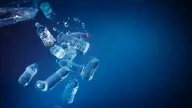Ocean-bound plastic
3 minute read
Creating a sustainable future
Innovation and sustainability are becoming increasingly synonymous as forward-thinking brands utilise technology and services to support sustainable habits.
Let’s take a look at the facts!
Every year, about 8 million tons of plastic waste escapes into the oceans from coastal nations. That’s the equivalent of setting five garbage bags full of trash on every foot of coastline around the world. Plastics often contain additives making them stronger, more flexible, and durable. But many of these additives can extend the life of products if they become litter, with some estimates ranging to at least 400 years to break down. Nearly 700 species, including endangered ones, are known to have been affected by plastics. Nearly every species of seabird eats plastics. Billions of pounds of plastic can be found in swirling convergences that make up about 40 percent of the world's ocean surfaces. At current rates plastic is expected to outweigh all the fish in the sea by 2050.
To overcome this ever-growing problem there are companies out there that are pressing forward with innovative ways to counteract these issues.
Meet Ocean Bound plastic.
Renowned professor, Jenna Jambeck PhD, popularised the ocean-bound concept following her extensive research article published in 2015. Jambeck found that 31.9 million metric tons per year of waste generated within coastal regions – defined as within 50km of the coastline – is categorised as mismanaged, which puts it at high risk of ending in the ocean. This is largely down to do with human history, geography and global deficiencies in waste management.
Much of the waste is generated by the vast swathes of densely populated areas which sit beside rivers, lakes or seas. This abundance of people contributes to one third of the total plastic waste generated each year.
Ocean recovered plastic is fished out from the ocean. Floating on the surface of the water on the shoreline or out to sea, sea floor plastics and deep-sea plastics cause detrimental impact. Ocean recovered plastic is fished out from the ocean. Floating on the surface of the water on the shoreline or out to sea, sea floor plastics and deep-sea plastics cause detrimental impact.
Ocean bound plastic can be used for hard goods made from rPET, rPP and rLDPE. Not only is this having a positive impact on the levels of plastic in the ocean, but the previously mentioned plastic materials are also the most commonly recycled. This is crucial in ensuring these items avoid landfills and incineration, and instead close the loop and give them a secondary purpose.
By turning ocean bound plastic waste into plastic yarn, brands can create items such as t-shirts and bags to give a new lease of life to the material. Creating goods from waste litter collected from our beaches and seas promotes this problem and puts it front of mind for consumers. We therefore see there being short term benefits in the shape of plastic waste being collected, and long-term benefits through the ongoing education of consumers.


